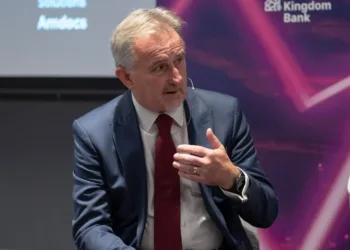What benefits can a coexistence model offer banks?
Nelson Wootton: When discussing coexistence models, it’s essential to grasp the underlying framework. Overhauling a core banking system is like performing open-heart surgery while the patient is still active. This daunting reality can leave financial institutions feeling vulnerable, with immense risks and often minimal rewards.
At SaaScada, we approach our partnerships with financial institutions differently. Our platform can generate data in multiple formats, facilitating a coexistence model. We can operate alongside an existing core system, producing data that integrates seamlessly with all management information and regulatory reporting, all while minimizing disruption.
This coexistence approach allows for a gradual migration, one product at a time, running alongside the old system instead of opting for a drastic ‘big bang’ transition. This strategy greatly enhances the chances of transformation while reducing risk and fostering innovation without significant exposure.
By adopting this model, we empower financial institutions to explore new products and markets without changing their core systems, a vital aspect of modern banking. This approach significantly alleviates risk for the bank’s board, which constantly prioritizes minimizing risk in every meeting.
What does financial inclusion mean to you, and how do you see its importance?
Steve Round: Having chaired The Big Issue Foundation and served on the board of Centenary Bank, the second-largest bank in Uganda focused on micro-finance, I have some reservations about the term ‘financial inclusion’. My concern lies in its potential to pigeonhole individuals into subpar offerings. It can create a perception that certain services are only for ‘those who need them.’
My true passion is for financial inclusivity—not exclusion. The greatest gift one can offer is self-worth. No one wants to be known as a customer of a ‘bank for the financially disadvantaged.’ Instead, they want access to quality financial services at fair prices.
SaaScada is designed to bridge micro-finance institutions in Africa with high-net-worth banks in Switzerland on a single platform. This structure keeps transaction costs low, making it possible to serve a broader audience while simultaneously providing adaptable products.
For instance, when we launched the Change Account, we were among the few providers in the UK—possibly even the world—offering lockable wallets. This feature enabled users to safeguard essential payments like rent and utilities, ensuring they weren’t impulsively spent after a night out. The same technology can be utilized by high-net-worth individuals for managing multiple currencies, including both traditional and cryptocurrencies.
Can you explain SaaScada’s ‘not on my watch’ mindset for senior executives?
Steve Round: Both Nelson and I embrace a certain level of madness because, to effect change in the world, a touch of enthusiasm and naivety is essential—especially when everyone is saying, ‘You can’t do that.’
A major challenge in the banking sector post-financial crisis is the introduction of the senior manager certification regime, which holds directors more accountable than ever. This has made crucial decisions surrounding core banking even more intimidating, particularly for non-executive directors.
As a company, we aim to ease some of those apprehensions through our technology and thought leadership. We emphasize that inaction is not viable—banks risk losing business if they fail to innovate.
Our core message is that coexistence carries far less risk than remaining stagnant. We’re committed to providing reassurance, drawing from our experiences to show that the risks of not adopting new technologies far exceed the risks of embracing them.
If you could be stranded on a desert island with three people, who would you choose and why?
Nelson Wootton: I briefly thought about picking Bear Grylls, but I realized that might be a common choice and he could be a bit intense to be around. So, I opted for Ray Mears instead; I think he would be easier to collaborate with, and he’d be in charge of our food and water supply!
For my next two selections, I wanted to think outside the box. The first is Lehua Kamalu, a member of the Polynesian Voyaging Society. They sail traditional canoes across vast distances using only natural navigation techniques. She would be invaluable to our team.
The second person is Sarah Marquis, a Swiss adventurer and author of *Wild by Nature*. She undertook an extraordinary 13,000-mile solo trek from Siberia to Australia and later spent three months in the Australian outback after being dropped off. With this trio, I am confident we can find our way back home!
Steve Round: Assuming we can include historical or religious figures, my first pick would be Noah since he could build us a boat, which seems like the most straightforward way to escape the island. I considered Bear Grylls as well, but like Nelson, decided to go with Ray Mears too.
Additionally, I chose Tim Berners-Lee because his intelligence—being the founder of the internet—could help us navigate off the island. So, my final lineup is Noah, Ray Mears, and Tim Berners-Lee. I believe Noah is our best bet for crafting a substantial vessel!




